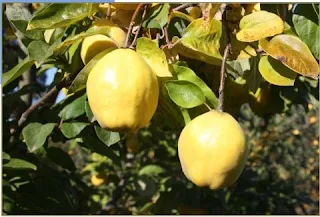 |
| I had some quince rootstock sucker and I mounded shredded brush over their bases them last summer. I also covered the pile of mulch with dog food bags. |
 |
| Etiolation is how plants respond to darkness. One happy outcome is that the sun does not destroy the growth regulators that would otherwise cause rooting. |
 |
| Well, lookie here! |
 |
| This is a bunch of rootstocks that I broke apart and planted. |
 |
| Some were on the skinny side for roots |
 |
| Others were well endowed. |
 |
| While planting the rootstocks I noticed a couple of peach seedlings. |
 |
| Close up of peach twig. |
Some pears cultivars are compatible with quince, which results in a dwarf pear tree. Here is a list of compatible cultivars from a reputable source.
Quince are staging a minor come back in their own right. Part of that is a growing interest in middle-Eastern cuisine.
Quince cultivars
 |
| This is a cultivar named Claribel. It was grown from seed collected in the Russian Federation...close to where the Battle of Stalingrad was fought. Do you suppose it gets cold there? |
The remainder of this post are lifted from a presentation Joseph Postman gave.
Postman lists 27 quince cultivars that were capable of surviving -30 F in December. Four were capable of surviving -40F. They did not test all of the cultivars in the collection but chose a cross section based on SSR genetic fingerprinting and a literature search looking for cultivars that had a reputation for being winter hardy.
This is the results of the SSR study. It gives you a feel for the Quince "family tree". The selections circled in green are ones that I am adding to my collection. The ones circled in red are examples of multiple cultivars being genetically identical.
 |
| This is a compilation based on several years of data. |
 |
| This is a gratuitous picture of a Quince. |
 |
| An image taken at the ARS Quince orchard in Oregon |


Good news! And the dwarf pears should do well...
ReplyDelete